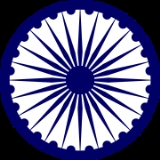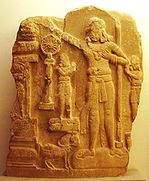
Ashoka Chakra
Encyclopedia


Edicts of Ashoka
The Edicts of Ashoka are a collection of 33 inscriptions on the Pillars of Ashoka, as well as boulders and cave walls, made by the Emperor Ashoka of the Mauryan dynasty during his reign from 269 BCE to 231 BCE. These inscriptions are dispersed throughout the areas of modern-day Bangladesh, India,...
, most prominent among which is the Lion Capital of Sarnath
Lion Capital of Asoka
The Lion capital of Ashoka is a sculpture of four "Indian lions" standing back to back. It was originally placed atop the Aśoka pillar at Sarnath, now in the state of Uttar Pradesh, India by Emperor Ashoka circa 250 BC. The pillar, sometimes called the Aśoka Column is still in its original...
which has been adopted as the National Emblem of the Republic of India.
The most visible use of the Ashoka Chakra today is at the centre of the National flag of the Republic of India
Flag of India
The National flag of India is a horizontal rectangular tricolour of deep saffron, white and India green; with the Ashok Chakra, a 24-spoke wheel, in navy blue at its centre. It was adopted in its present form during a meeting of the Constituent Assembly held on 22 July 1947, when it became the...
(adopted on 22 July 1947), where it is rendered in a Navy-blue color on a White background, by replacing the symbol of Charkha (Spinning wheel
Spinning wheel
A spinning wheel is a device for spinning thread or yarn from natural or synthetic fibers. Spinning wheels appeared in Asia, probably in the 11th century, and very gradually replaced hand spinning with spindle and distaff...
) of the pre-independence versions of the flag.
Sarvepalli Radhakrishnan
Sarvepalli Radhakrishnan
Sir Sarvepalli Radhakrishnan , OM, FBA was an Indian philosopher and statesman. He was the first Vice President of India and subsequently the second President of India ....
, who later became India's first Vice President, described the flag as follows:
It is also thought that it represents 24 states of India, which were present when India was formed.
See Also
- Lion Capital of Ashoka
- National Flag of India
- National Emblem of India
- ChakravartinChakravartinChakravartin , is a term used in Indian religions for an ideal universal ruler, who rules ethically and benevolently over the entire world. Such a ruler's reign is called sarvabhauma. It is a bahuvrīhi, literally meaning "whose wheels are moving", in the sense of "whose chariot is rolling...

